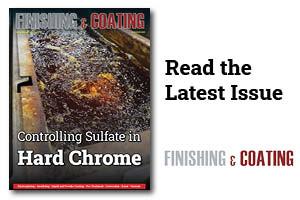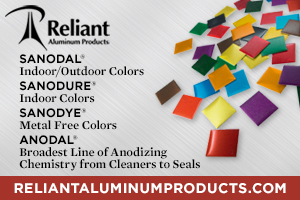A company wrote to me that they rack electroplates a flash of brass over bright nickel, and were having a hard time getting the color right.
 Frank AltmayerIt seemed to them that the plating solution plates every color but the one we were looking for, which was a green-yellow. They reported that the solution is very unstable and they are constantly tweaking it. Sometimes it works and, at other times, they make a lot of rejects that are costing them millions of dollars per year.
Frank AltmayerIt seemed to them that the plating solution plates every color but the one we were looking for, which was a green-yellow. They reported that the solution is very unstable and they are constantly tweaking it. Sometimes it works and, at other times, they make a lot of rejects that are costing them millions of dollars per year.
Brass plating can indeed be a nightmare, and I consider it to be the second-most troublesome plating solution — after bronze — to operate.
Let’s get into this process and discuss your situation, without revealing details about their specific application, since I signed a confidentiality agreement.
While the ingredients to a brass plating solution are basic, the formulations are quite numerous. I would guess that there are close to 100 formulations in the literature.
Basic Ingredients
The basic ingredients for a conventional brass plating process and their impact (if any) on color are the following:
Copper Cyanide
The copper cyanide is obviously present to provide cyanide-complexed ions that can be reduced at the cathode simultaneously with zinc ions (also complexed with cyanide) to produce an alloy deposit that will be part copper and part zinc. The concentration of copper (as a ratio with zinc) will impact the color of the deposit. I am aware that some authors don’t agree with this. Still, based on my experience, brass platers typically look for color differences that are so slight that most people would never be able to see them. I have seen brass that looked absolutely gorgeous to me, only to have the QA/ QC guy tell me, “It’s too red!”
Zinc Cyanide
The role of zinc cyanide has been covered in the preceding paragraph. In alkaline brass plating formulations (above pH 10.5), some of the zinc in the solution exists as the zincate (Na2ZnO2) complex, as well as the cyanide complex (Na2Zn(CN)4). See the previous paragraph for a discussion of the impact of metal content on the color of the deposit.
I should note that the ratio of copper to zinc (typically anywhere from 2.5–4.2:1) cannot be interpreted literally to impact color along the lines of the ratio. In other words, a brass plating solution with a high copper-to-zinc ratio does not necessarily produce a redder brass plate. That’s what drives platers crazy! There are so many other variables that affect the color, and they all must be controlled. I would start with a conventional formulation, keep the ratio of copper to zinc as constant as possible, and then adjust the other ingredients accordingly to yield a brass that is “in control.”
Sodium Cyanide
Because neither copper cyanide nor zinc cyanide is soluble in water, you need to add sodium cyanide to convert these compounds to the soluble complexes indicated in the previous paragraph. The excess sodium cyanide in the solution (beyond that needed to form the soluble complexes) is called the “free” cyanide. The “true” amount of free cyanide present in the brass plating solution is a function of the solution's pH (increasing as the pH increases), as per Analysis of Electroplating and Related Solutions, Fourth Edition. Kenneth E. Langford, consultant, Robert Draper Ltd., Teddington, England.
The role of free cyanide is to form soluble complexes with copper and zinc ions, which dissolve at the anode. In other words, we need free cyanide to dissolve the anodes. Free cyanide has a big impact on both the color and stability of the plating solution. High free cyanide increases the zinc in the deposit, affecting the color. Low free cyanide levels decrease the zinc content in the deposit, also affecting the color, and “polarizing” the anodes, causing the plating solution to operate in an unstable manner. This is because the polarized anodes cause the solution to vary in copper and zinc concentration—you will find yourself adding copper and zinc cyanide to replenish what was plated out. The addition of either of these also requires a careful addition of sodium cyanide to maintain the free cyanide. If that addition isn’t done carefully, the free cyanide is impacted, and the consequences are severe.
Sodium Carbonate
A small amount of sodium carbonate is added to a new solution to provide pH buffering at the typical pH of most brass plating solutions—around 10–
10.5. Two to four oz/gal (15-30 g/L)— can be beneficial for added conductivity, as well. High carbonates (>12 oz/ gal) can reduce conductivity dramatically, however, and should be removed using low-temperature crystallization (if possible).
Sodium carbonate has little or no impact on color, but pH does. The higher the pH, the higher the zinc content in the brass plate (and, of course, that affects the color of the deposit). The pH needs to be controlled within 0.2 units. Add sodium hydroxide to raise the pH and sodium bicarbonate to lower it. This is a good time to emphasize that you never add sulfuric acid to lower the pH of a brass plating solution (or any cyanide plating solution). While this sounds like common sense, I actually had a plater call me once to ask the question:
“What do I add to lower the pH of my brass solution? I’ve already added two gallons of sulfuric acid, and it doesn’t seem to be working.” Ouch.
Ammonium Hydroxide
Ammonium hydroxide, a key ingredient, dramatically affects the color and luster of the brass deposit. The actual mechanism isn’t well understood, but ammonia is known to be a complexing agent for copper, so it can be expected to increase the zinc in the deposit.
There are other ways to increase the zinc in the deposit, which we will cover later, but an increase of zinc using these other methods does not produce the dramatic color change that ammonia produces. Without ammonium hydroxide in the solution, or if the ammonium hydroxide (ammonia) is low in concentration, the solution becomes increasingly sensitive to variations in agitation. A solution that has no ammonia will plate a “rainbow” of colors from red to yellow, depending on agitation and current density, assuming all other variables remain steady.
Ammonia is not a stable ingredient in brass plating solutions, especially when the operating temperature exceeds 32° °C (90°°F). Analyzing the ammonia content is difficult, so most platers go by the appearance of a plated Hull cell panel. Typical ammonia concentrations are 0.1–0.5 percent volume. The lower the concentration of ammonia, the more unstable the color tends to be, so I favor a higher concentration and would recommend the high end of this range. Too much of a good thing often is bad, however, and the same is true of ammonia in a brass solution. High concentrations of ammonia will render the brass plate with streaky white deposits.
Other ammonia-like compounds can be used in brass plating solutions to achieve a measure of the benefits obtained from ammonia. Still, they are less effective, more difficult to control, and contaminate the solution over time, resulting in a narrower range of uniform colors compared to the normal range of current density. Two of the amine compounds in the literature are monoethanolamine and ammonium chloride. Note: Don’t use ammonium chloride with steel or titanium anode baskets because they will be destroyed.
Rochelle Salts
Rochelle salts (a.k.a. sodium-potassium-tartrate) assist the free cyanide in corroding the anodes. There are commercially produced anode depolarizers that can be added as well. Because either of these options acts as a complexor of dissolved metals, an impact on color will occur if the concentration of either ingredient is too low; on the other hand, there seems to be little impact on color if the concentration exceeds the normal range of 4–6 oz/gal (30–60 g/L) of Rochelle salts.
Other ingredients can be added to a brass, but I’m not in favor of it because all it does is add another variable (and by now it’s obvious there are too many already).
Operating Variables
As you might expect, the operating variables will also impact the color of the deposit:
Temperature: As the temperature increases, the percentage of copper in the deposit also increases, affecting the color accordingly. If at all possible, try to operate the solution below 100°°F, because the solution will be more stable.
Agitation: A higher level of agitation favors the copper content of the brass deposit if the solution is low in ammonia content, or if there is none at all. In the presence of a sufficient amount of ammonia, the level of agitation has no significant impact on the color.
Cathode Current Density: Higher current densities favor the zinc in the deposit and will impact the color accordingly. Typical current densities are 5–10 A/ft2 for rack plating. A typical brass plating solution operates at low current densities and elevated temperatures, with cathode rod or other agitation.
Anodes: Anodes used are normally made from the same alloy that is being deposited. Separate copper and zinc anodes can be used, but are troublesome to control. Cast or rolled anodes in slab, balls, and flat chips (in baskets) are also suitable. Anodes should be a solid solution, single-phase, to allow for uniform solution of both metals. If they don’t dissolve uniformly, the copper-to-zinc ratio of the plating solution will change, and the color will be affected. The color is also affected by impurities that may be in the anodes, especially lead and tin.
Neither lead nor tin should be at levels above 0.03 percent. Well-operating anodes have a noticeable dark film.
Each constituent in a brass solution has a specific function. When these ingredients are out of balance, they will typically have a profound impact on the color of the brass deposit.
Frank Altmayer is a Master Surface Finisher, an AESF Fellow, and the technical education director of the AESF Foundation and NASF. He owned Scientific Control Laboratories from 1986 to 2007 and has over 50 years of experience in the metal finishing industry. He received the AESF Past Presidents Award, the NAMF Award of Special Recognition, the AESF Leadership Award, the AESF Fellowship Award, the Chicago Branch AESF Geldzahler Service Award, and the NASF Award of Special Recognition.



































